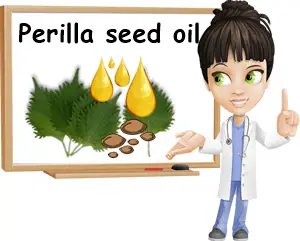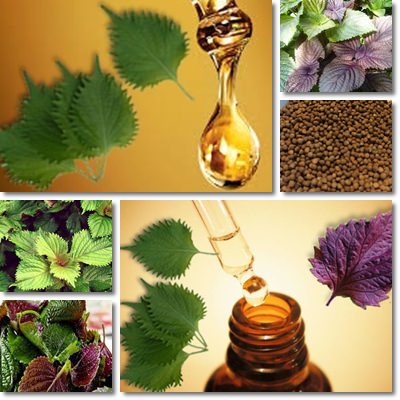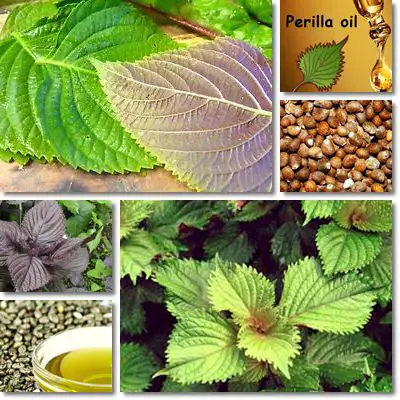Perilla oil is a popular edible oil in Asian cuisine and a generous source of essential fatty acids, notably alpha-linolenic acid, the plant form of Omega-3 and linoleic acid, an important Omega-6 fatty acid.
Among its most popular uses, perilla oil is said to help with allergies, reduce inflammation markers in the body, improve rheumatoid arthritis, reduce the risk of cancer overall and contribute to cardiovascular health by reducing the risk of blood clots, cholesterol plaques, heart attack and stroke.
What is perilla oil made of?
Perilla oil is most commonly extracted from seeds, although the leaves too yield oil. However, perilla oil generally refers to the oil obtained from pressing the seeds.
The difference between the two is that perilla seed oil contains alpha-linolenic acid, a form of Omega-3 specific to plant sources, while the leaf oil doesn’t.
The oil is obtained from the Perilla frutescens species, with two major varieties, Perilla frutescens var. crispa, also called shiso in some parts of the world, and Perilla frutescens var. frutescens, also known as the oilseed perilla. Both varieties can have either green or purple foliage. Also see benefits of shiso leaves, aka perilla.

Perilla frutescens is a plant native to Asia and belongs to the mint family, which would explain its alternative names: perilla mint, wild basil, Chinese basil and purple mint to distinguish between the green and scarlet-purple varieties.
The leaves, seeds and oil obtained from either of them as well as the sprouts are all edible. The oil is obtained by crushing the seeds, a process more appropriately called pressing. The seeds may be roasted first for a more intense flavor.
Fatty acids profile of Perilla Seed Oil
On average, perilla seeds yield 35% to 45% oil, with half or more of it (54 to 64%) being ALA, alpha-linolenic acid, the plant form of Omega-3. About 14% is linoleic acid, an Omega-6 fatty acid.
The rest is oleic acid, an Omega-9 (source).
Health effects of Perilla Seed Oil
Perilla seed oil is valued for its many purposes, primarily medicinal and culinary, but also industrial.
Some of the most notable properties and health effects of perilla seed oil include the following:
1) Strong anti-inflammatory action
The anti-inflammatory action of perilla seed oil is a result of several compounds, notably Omega-3 fatty acids and rosmarinic acid. Both compounds have been shown to suppress inflammatory responses and contribute to lower levels of inflammation markers in the body.
The anti-inflammatory action of the Omega-3 fatty acids in the oil is more pronounced on the cardiovascular and nervous systems, while rosmarinic acid appears to exert its strongest action on the immune system, suppressing allergic mediators, but also inhibiting inflammatory responses.

2) Cardiovascular benefits
Perilla seeds yield impressive amounts of Omega-3 fatty acids along with moderate to small amounts of Omega-6 and Omega-9, which are all passed into the resulting oil.
The Omega-3 Omega-6 ratio of 54-64% to 14% makes perilla oil particularly healthy for the cardiovascular system. Normally, we are advised to maintain a 1:1 to 1:4 Omega-3 Omega-6 ratio for optimal health, with perilla seed oil providing the much needed Omega-3. Too much Omega-6 can lead to cholesterol plaques, blood clots, hypertension, strokes and heart attack.
Having an Omega-3 intake closer to the recommended values has been shown to discourage blood clotting and raise HDL (good) cholesterol while lowering LDL (bad) cholesterol levels, thus aiding in the prevention of cholesterol plaques on the inside of artery walls and subsequent inflammation, ruptures, high blood pressure, heart attack and stroke.
ALA, the Omega-3 in perilla seed oil, has been found to encourage the body to produce anti-inflammatory substances, further combating cardiovascular disease and the whole range of chronic diseases heavily relying on inflammation.
3) Antioxidant properties.
The entire perilla plant is a rich source of potent antioxidants with wonderful health effects. The leaves contain polyphenols such as caffeic acid, rosmarinic acid, flavonoids and anthocyanins (in the purple varieties), all compounds with high antioxidant value, according to a study called Antioxidant Activities of Polyphenols Extracted from Perilla frutescens Varieties.
The seeds themselves contain important antioxidant compounds, notably rosmarinic acid, quercetin, apigenin, shishonin, luteolin and so on, all of which are passed on into the oil, not to mention essential fatty acids with a strong antioxidant activity.
Antioxidants protect against the harmful action of reactive oxygen molecules called free radicals. Free radicals cause damage at cellular level, disrupting normal cell function. This engenders inflammatory responses, encouraging chronic disease development and may even cause cells to go haywire and turn cancerous.
4) Boasts anticancer properties
The antioxidants present in perilla oil boast impressive free radical scavenging properties, meaning they scavenge harmful reactive oxygen molecules and prevent them from causing serious damage to cells and tissues.
If left to run its course, the oxidative stress caused by free radicals disrupts normal cell activity and may cause cells to turn cancerous.
The anti-inflammatory action of perilla oil also plays a part in offering protection against various forms of cancer as inflammation is directly responsible for disarranging normal cell activity.
According to a paper called Recent studies on rosmarinic acid and its biological and pharmacological activities, rosmarinic acid present in perilla oil can decrease oxidative stress, reduce inflammation and regulate apoptosis (programmed cell death) in the kidneys.
It can inhibit the production of reactive oxygen species responsible for inflammation and chronic disease development. Moreover, the compound has been found to potentially improve inflammatory conditions and even prevent or stop the progression of colon cancer in animal studies, skin and mouth carcinogenesis and lung nodules and some benign tumors.

5) Efficient against allergies
Rosmarinic acid in perilla oil has been found to inhibit inflammatory responses, contributing to seasonal allergy and asthma management. Both perilla seeds and the oil extracted from them can help improve lung function and breathing in asthma sufferers as a result of their ALA (alpha-linolenic acid) content.
This type of Omega-3 fatty acid appears to inhibit the production of leukotriene C4, a type of inflammatory mediator in white blood cells responsible for effects such as breathing difficulties in asthma sufferers (source).
6) May help with rheumathoid arthritis
The Omega-3 fatty acids in perilla seed oil (alpha-linolenic acid) appear to partially inhibit the production of certain inflammation markers in the body responsible for tissue damage in various inflammatory conditions such as rheumatoid arthritis.
This is believed to contribute to improving rheumatoid arthritis symptoms and even reduce the need for anti-inflammatory medication.
7) Antibacterial properties
Perilla oil exhibits a moderate antimicrobial activity against 13 selected bacteria and viruses, including Staphylococcus aureus and Streptococcus pyogenes. Its antimicrobial properties are a result of specific compounds in the oil (source).
8) Excellent for skin care
Rosmarinic acid in perilla seed oil has been shown to potentially help in the treatment of atopic dermatitis. The oil in itself is a wonderful skin emollient and regular topical use is extremely efficient for dry skin.
Moreover, the oil is reported to help reduce clogged pores, even help with cysts and acne when applied topically. This effect might be a result of the antimicrobial activity of rosmarinic acid against skin-inhabiting bacteria such as Staphylococcus aureus and Streptococcus pyogenes, but also a result of the anti-inflammatory activity of the Omega-3 fatty acids in perilla.
9) Good for brain health
Being an excellent source of Omega-3 fatty acids, perilla seed oil contributes to improving brain function and nervous system health. The fatty acid has been shown to even offer a certain protection against neurodegenerative diseases such as Parkinson’s disease and has exhibited a reparative action on the nervous system. Also see benefits of perilla leaf oil.
What does perilla seed oil look like?
Perilla oil has a clear, light yellow color and a more fluid texture (unlike other, more viscous oils).
What does perilla seed oil taste and smell like?
Perilla oil tastes somewhat like sesame oil, but boasts a richer, more intense flavor and a distinct fragrance. Because of its strong aroma, it has been used as a flavoring agent.
How is perilla seed oil preserved?
Being highly perishable, it is best kept in a cool, dark, dry place and best used before one year.
